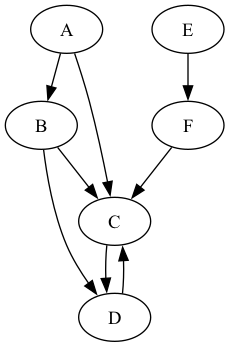Data Structure and Algorithm Design
Chapter 14
Xingang (Ian) Fang
Sections
Graph
Graph Traversal
Single Source Shortest Path (SSSP) Dijkstra’s Algorithm
Graph
Xingang (Ian) Fang
Outline
Overview
Concepts
Example graphs
Representations
Algorithms
Overview
Graphs are a fundamental data structure in computer science.
Graphs are used to model networks, complex relationships, etc.
Vertices(nodes) connected by edges.

Applications
Social networks
Routing algorithms
Computer networks
Transportation and logistics
Machine learning/deep learning
Bioinformatics
Integrated circuit design
Database systems
Computer vision
Optimization problems
Game development
Concepts
Vertex/Node
degree of vertex
degree of graph
Edge/Arc
directed/undirected
weighted/unweighted
Connectivity
path between two vertices
length of path
distance between two vertices
adjacent
connected / unconnected
cyclic / acyclic
Graph level properties
directed/undirected
weighted/unweighted
cyclic/acyclic
connected/unconnected
dense/sparse
Examples
![digraph G {
node[shape=circle];
a -> {b, c, d};
b -> {a, d};
}](../_images/graphviz-25726c5530fd71359db4f8e8ea62a7ef76bbc66b.png)
Directed connected cyclic graph
![graph G {
node[shape=ellipse];
Atlanta -- Dallas [label=4];
Atlanta -- Miami [label=4];
Atlanta -- Orlando [label=3];
Dallas -- Austin [label=1];
Dallas -- Orlando [label=6];
}](../_images/graphviz-637bd5e0c7f41a966d38e7ed8d9a81fb4b4a71d2.png)
Undirected connected cyclic weighted graph
![graph G {
node[shape=circle];
b -- a;
a -- {c, d};
b -- {e, f};
}](../_images/graphviz-4b4f6033c52eb9415f2faaf7afeab5e31906ce13.png)
Undirected connected acyclic graph (Tree)
![digraph G {
rankdir=LR;
node[shape=box];
task1 -> task2;
task2 -> {task3, task4};
task3 -> {task5, task6};
task4 -> task6;
}](../_images/graphviz-00d99992acd71caa0527cac5c3a3faa9c2a8f36f.png)
Directed acyclic graph (DAG) task planning
Representations
Vertices with pointers to neighbors (uncommon)
List of edges
A list of edges is a 1d array in which every element in the array represents an edge. It is the simplest way to represent a graph. It is also an easy way to store a graph in a relational database. It is not efficient for most graph algorithms though.
Adjacency list
An adjacency list is a 1d array in which every element in the array represents a vertex and points to a list of its neighbors.
Adjacency matrix
An adjacency matrix is a 2d array in which each row represents a source vertex and each column represents a destination vertex. The elements in the matrix represents the edge between the two vertices.
Algorithms
Graph traversal
Breadth-first search
Depth-first search
Topological sort (DAG only)
Shortest path
Dijkstra’s algorithm (single source, greedy)
Floyd-Warshall Algorithm (all pairs, dynamic programming)
Minimum spanning tree
Prim’s algorithm (greedy)
Kruskal’s algorithm (greedy)
Graph Traversal
Overview
Depth First Search (DFS)
Breadth First Search (BFS)
Visualization
Overview
Start from a vertex
Visit all reachable vertices connected to it in a systematic order
Two common ways to traverse a graph
Depth First Search (DFS)
Breadth First Search (BFS)
Depth First Search (DFS)
Like walking in a maze, you go as far as you can, then backtrack
Stack based implementation
function dfs(startVertex):
create a new stack
push startVertex onto the stack
mark startVertex as visited
while the stack is not empty:
current = pop from the stack
process(current) # Perform an action on the current node
for each neighbor in current.neighbors:
if neighbor is not in visited set:
push neighbor onto the stack
add neighbor to the visited setRecursive implementation
function dfs(vertex, visited):
if vertex is not visited:
mark vertex as visited
visit(node) # Perform an action on the vertex
for each neighbor of the vertex:
if neighbor is not visited:
dfs(neighbor, visited)Breadth First Search (BFS)
Like a wave, you visit all vertices at the same level before going deeper
Queue based implementation
function bfs(startVertex):
create a new queue
enqueue the startVertex
mark the startVertex as visited
while the queue is not empty:
dequeue a vertex from the queue
process(vertex) # Perform an action on the vertex
for each neighbor of the vertex:
if neighbor is not visited:
mark the neighbor as visited
enqueue the neighborVisualization
Dijkstra’s Algorithm
Single source shortest path algorithm
Greedy algorithm
visualization
function dijkstra(graph, source):
create a priority queue PQ
initialize distances to all vertices as infinity
set the distance to the source as 0
enqueue source to PQ
while PQ is not empty:
current_vertex = vertex with the smallest distance in PQ
remove current_vertex from PQ
for each neighbor of current_vertex:
edge_weight = weight of the edge between current_vertex and neighbor
tentative_distance = distance to current_vertex + edge_weight
if tentative_distance < distance to neighbor:
set distance to neighbor as tentative_distance
add neighbor to PQ